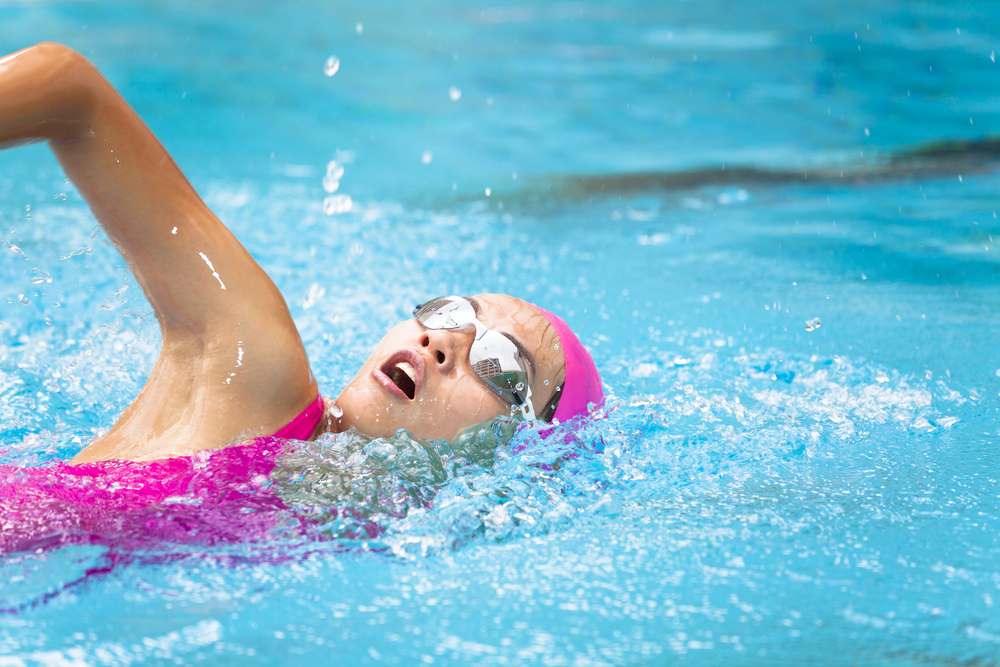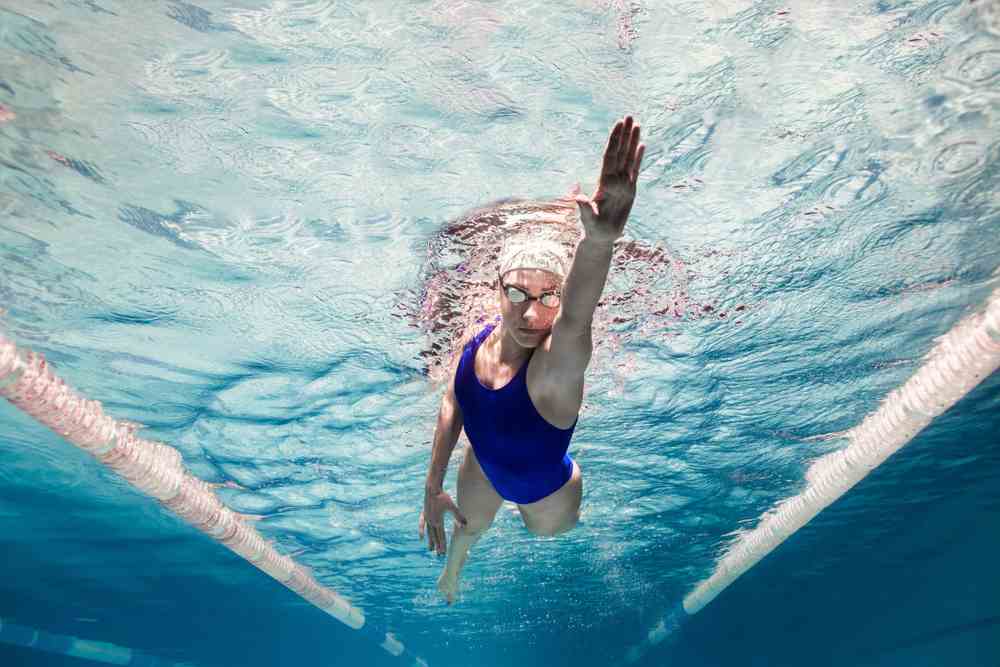Swimming is a great exercise to improve your overall orthopedic health. In fact, swimming is actually one of the most popular activities among Americans. Unlike some exercises and activities, swimming is considered a low-impact activity, which means it is gentler on your muscles and joints. If you experience joint pain or are recovering from a musculoskeletal injury, swimming can help you stay active while you recover without making your pain worse. Swimming offers such a wide range of health benefits for people of all ages and activity levels. Young children learn how to practice water safety while improving their lung capacity and endurance levels. Older adults will appreciate swimming because it is gentle on your joints while still helping you improve muscle strength, flexibility, and heart health.
Swimming: The Head-to-Toe Workout
 Do you want to improve your health but find cardio workouts intimidating or uncomfortable? Swimming offers a great alternative where you still get a great cardio workout without all the sweat and stress. When you swim, the water helps keep you cool and actually encourages you to continue staying active longer than you might otherwise, especially on a hot day. Many people also find water relaxing, and what better way to get some exercise in when it can be enjoyable, too. Swimming engages your whole body, giving you a great workout from head to toe. You use your arms and legs to propel you with various swim strokes while also engaging your back, core, and glutes. Exercising in water also provides additional resistance while you move your limbs through the pool while swimming. Water also gives you more buoyancy so you can float while exercising, which takes additional pressure off your joints.
Do you want to improve your health but find cardio workouts intimidating or uncomfortable? Swimming offers a great alternative where you still get a great cardio workout without all the sweat and stress. When you swim, the water helps keep you cool and actually encourages you to continue staying active longer than you might otherwise, especially on a hot day. Many people also find water relaxing, and what better way to get some exercise in when it can be enjoyable, too. Swimming engages your whole body, giving you a great workout from head to toe. You use your arms and legs to propel you with various swim strokes while also engaging your back, core, and glutes. Exercising in water also provides additional resistance while you move your limbs through the pool while swimming. Water also gives you more buoyancy so you can float while exercising, which takes additional pressure off your joints.
7 Health Benefits of Swimming
Swimming offers great health benefits for all ages and is a great option for beginners. You don’t even need any equipment to get a great workout from a swim. Here are seven benefits of swimming for your next aerobic workout.
Works your whole body
Swimming provides a total body workout. After you swim for exercise the first few times, you might even notice slight soreness in places you didn’t even realize you used while swimming. You use your arms to scoop or slice through the water and propel you forward while also engaging your hips and legs for propulsion, too. When you swim, your body will try to naturally straighten and lengthen your spine, and your back and abdominal muscles get a great workout holding you in your swimming posture. Even your lungs get a great workout while you swim because learning how to breathe properly while swimming can help expand your lung capacity and give you better control over your breathing.
Helps you burn calories
Going for a swim can also help you burn calories! Swimming for a few hours each week will give you a great cardiovascular workout that engages your whole body and helps you burn calories and shed extra pounds. You can get in shape by swimming a few times a week and burn calories without breaking a sweat. If you are recovering from an injury, then you may need to refrain from certain activities you used to depend on for a workout. Swimming can be a way for you to still work out without making your injury worse and keep you from gaining weight due to inactivity. When your limbs are more buoyant, you might end up exercising for longer than you would on land.
Improves your posture
When you swim, you engage your core muscles that help support a healthy posture. When you think of your core, you might just think of your abdominal muscles. However, your core also includes other muscles and tissues that support your spine and torso. Swimming helps strengthen these muscles, which provide stability and support so you can have better posture. Whether during swimming or while sitting at your desk, having good posture offers numerous health benefits like reducing your pain and discomfort.
Reduces joint pain
People who deal with joint pain either from a recent injury or a health condition like osteoarthritis will appreciate a low-impact activity like swimming. Too much stress and pressure on your joints can make certain movements and activities uncomfortable. When you are in the water, it helps you float, which takes some pressure off all your joints. This also allows you to move more freely because it puts less stress and weight on your aggravated joints. You may also find warm water to be soothing to your painful joints.
Eases muscle tension
The buoyancy of water can also help soothe tense muscles. You may not even realize just how much muscle tension you are carrying around until you get into a swimming pool. As the water supports your body, you can move around more freely, which gives your muscles a chance to stretch and flex with less pressure or stress. People also tend to find pools and bodies of water relaxing, which can boost your mood and ease your tension. Swimming can also help improve your sleep quality because aerobic activity gives your muscles such a great workout. It allows you to relax and boost your overall quality of life.
Boosts your recovery
When you swim, your body releases endorphins, commonly known as the feel-good hormones. These hormones can boost your energy and make you more confident as you go through the recovery process. If you are recovering from an injury, resting from certain activities that worsen your symptoms is important. Swimming typically offers a low-impact and gentle option to keep your body moving and prevent you from getting stiff and sore because of inactivity. Swimming is also a heart-healthy activity that gets your blood pumping and can help lower your blood pressure.
Lowers injury risk
You might be surprised to learn that swimming can also lower your risk for injury in the future! That’s because when you swim, your whole body gets stronger. When you are strong and healthy, your muscles can help keep you stable and prevent falls. Your movements also become more fluid, and you develop greater flexibility, which can benefit you while playing sports or recreational activities. Swimming helps you build endurance so that you can play harder and last longer while participating in other activities you enjoy.
Swimming Tips for Improving Your Orthopedic Health
Check out these tips on how to swim in a way that best supports your orthopedic health so you can reap the most benefits out of this great exercise.
Learn to swim with proper form
 Practicing proper form is so important no matter what exercise or activity you engage in. When you swim, you get a better workout when you use proper form. Your local gym or community center may even offer classes on different swimming strokes so you can learn more about what proper form looks and feels like in the pool. Using good stroke techniques will help you get the most out of swimming as an effective workout.
Practicing proper form is so important no matter what exercise or activity you engage in. When you swim, you get a better workout when you use proper form. Your local gym or community center may even offer classes on different swimming strokes so you can learn more about what proper form looks and feels like in the pool. Using good stroke techniques will help you get the most out of swimming as an effective workout.
Practice rhythmic breathing
When you swim, you want to practice rhythmic breathing in a way that best supports your lungs. Proper breathing technique for swimming includes constantly exhaling to prevent you from holding your breath and tensing up. When you breathe in, you want to make sure you have fully exhaled. Rhythmic breathing can also help you swim straighter and stronger for longer periods of time.
Gradually increase intensity & duration
As you develop a regular swimming routine, you will notice that you are able to swim for longer periods of time and with greater intensity. Regular swim training can even help improve your intensity and duration during other activities on land, like running longer distances. Swimming teaches you great breath control and helps build strong muscles, which you can then use to engage in other exercises and activities.
Always practice water safety whether you are swimming for exercise or just for fun. Never swim alone; always make sure there is a lifeguard on duty or you have a friend nearby to keep an eye on you. Learn what your limits are depending on the body of water and your comfort level with different depths. Avoid swimming out too far away from the shore if you are in a lake or the ocean. Only dive into water if you know exactly how deep the water is and that the area is clearly marked as a safe space for diving.
Visit your Marietta physical therapist at AICA Orthopedics and learn more about how you can safely recover from an injury with low-impact exercises like swimming. Physical therapy can also help prepare your muscles for swimming so you can get the most out of this activity. At AICA Orthopedics, our team of Marietta doctors includes orthopedists, neurologists, chiropractors, and physical therapists who work together to provide you with personalized treatment and comprehensive care.